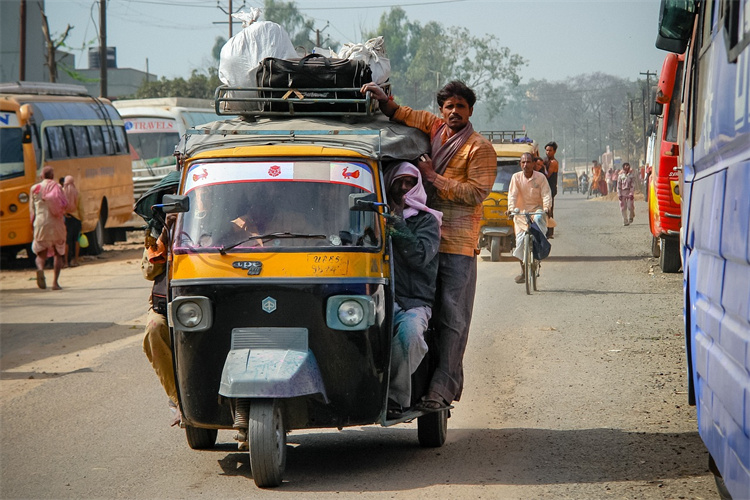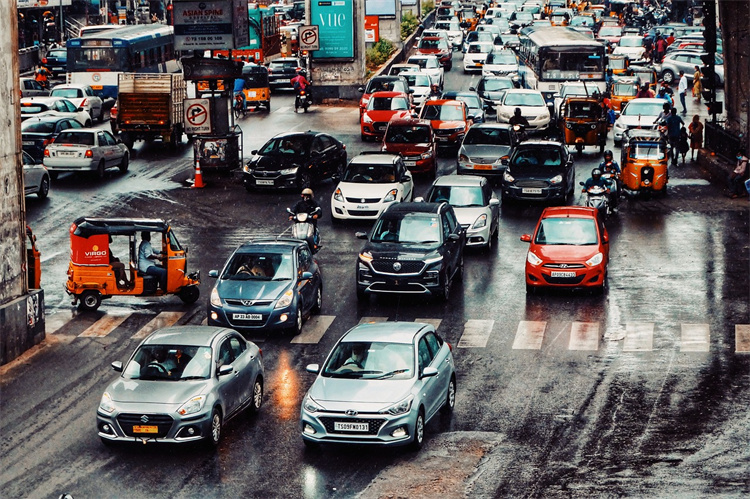The Current State of Local Logistics and Supply Chain in India

Local logistics plays a crucial role in India's economy. The sector has experienced rapid growth, driven by the expanding economy and increasing foreign trade. The Indian logistics market was valued at approximately USD 435.43 billion in 2023. Logistics expenses account for about 14 percent of the country's Gross Domestic Product (GDP). Understanding the current state of local logistics is essential to grasp the challenges and opportunities within this dynamic industry.
Challenges in Local Logistics and Supply Chain

Infrastructure Issues
Poor Road Conditions
India's road infrastructure often faces significant challenges. Many roads remain in poor condition, affecting transportation efficiency. Poor road conditions lead to delays and increased vehicle maintenance costs. These issues hinder the smooth flow of goods across the country. For instance, Company X's supply chain transformation highlighted how poor road conditions impacted delivery times and operational costs.
Inadequate Warehousing Facilities
The logistics sector in India also grapples with inadequate warehousing facilities. Many warehouses lack modern amenities and proper storage conditions. This inadequacy results in higher spoilage rates and inefficiencies. A leading manufacturer of pet foods in India faced high transit times and error margins due to inefficient warehousing. Improving warehousing infrastructure is crucial for enhancing local logistics.
Regulatory Hurdles
Complex Taxation System
India's complex taxation system poses another challenge. Multiple taxes and varying state regulations complicate logistics operations. Businesses often struggle with compliance, leading to delays and increased costs. Simplifying the taxation system can significantly improve logistics efficiency.
Compliance and Documentation
Compliance and documentation requirements add another layer of complexity. Companies must navigate a maze of paperwork and regulatory approvals. This process often leads to delays and increased administrative costs. Streamlining compliance procedures can help businesses operate more smoothly.
Workforce Challenges
Skill Gaps
The logistics sector in India faces significant skill gaps. Many workers lack the necessary training and expertise. This gap affects productivity and operational efficiency. Investing in workforce training programs can help bridge this gap and improve overall performance.
Labor Shortages
Labor shortages present another challenge. The logistics industry often struggles to find enough skilled workers. High attrition rates exacerbate this issue. Addressing labor shortages requires strategic planning and investment in human resources.
Opportunities in Local Logistics and Supply Chain
E-commerce Growth
Increased Demand for Last-Mile Delivery
The rise of e-commerce has significantly impacted local logistics. Consumers demand faster delivery times. This shift has increased the need for efficient last-mile delivery solutions. Companies invest in technology to optimize delivery routes. Improved last-mile delivery enhances customer satisfaction and loyalty.
Expansion of Online Retailers
Online retailers continue to expand their presence in India. The growth of online shopping platforms has created new opportunities for local logistics providers. These companies must adapt to handle higher volumes of orders. Efficient logistics operations are crucial for meeting consumer expectations. The expansion of online retailers drives innovation in supply chain management.
Investment in Infrastructure
Development of Logistics Parks
Investment in infrastructure plays a vital role in improving local logistics. The development of logistics parks provides modern facilities for storage and distribution. These parks offer advanced amenities and better connectivity. Logistics parks help reduce transit times and operational costs. Government initiatives support the establishment of these facilities.
Improvement in Transportation Networks
Improving transportation networks is essential for efficient local logistics. Investments focus on enhancing road, rail, and port infrastructure. Better transportation networks facilitate the smooth movement of goods. Companies benefit from reduced transit times and lower transportation costs. Improved infrastructure strengthens the overall supply chain.
Technological Advancements
Adoption of AI and Machine Learning
Technological advancements drive significant improvements in local logistics. The adoption of AI and machine learning optimizes various aspects of the supply chain. Predictive analytics helps forecast demand and manage inventory. AI-powered systems enhance route planning and reduce delivery times. Companies leverage these technologies to gain a competitive edge.
Use of IoT and Blockchain
The use of IoT and blockchain technology transforms local logistics. IoT devices provide real-time tracking and monitoring of shipments. Enhanced visibility improves asset management and reduces losses. Blockchain ensures secure and transparent transactions within the supply chain. These technologies increase efficiency and trust among stakeholders.
Technological Advancements

Automation and Robotics
Impact on Warehousing
Automation and robotics have revolutionized warehousing in India. Automated systems streamline sorting, packing, and inventory management. Robots handle repetitive tasks, reducing human error and increasing efficiency. Warehouses equipped with automation experience faster processing times. This technology minimizes operational costs and enhances productivity.
Efficiency in Transportation
Robotics also improve transportation efficiency. Automated guided vehicles (AGVs) transport goods within warehouses and distribution centers. These vehicles follow pre-defined paths, ensuring timely and accurate deliveries. Drones assist in last-mile delivery, reaching remote areas quickly. The integration of robotics in transportation reduces transit times and operational costs.
Data Analytics
Predictive Analytics for Demand Forecasting
Data analytics plays a crucial role in demand forecasting. Predictive analytics uses historical data to anticipate future demand. Companies can optimize inventory levels, reducing stockouts and overstock situations. This approach improves customer satisfaction by ensuring product availability. Predictive analytics helps businesses make informed decisions and plan effectively.
Real-time Tracking and Monitoring
Real-time tracking and monitoring enhance supply chain visibility. IoT devices provide live updates on shipment locations and conditions. Companies can monitor temperature, humidity, and other factors affecting goods. This technology allows for prompt action in case of disruptions. Real-time tracking ensures transparency and builds trust among stakeholders.
Study Title: Impact of Technological Advancements in Indian Logistics
Key Findings: The logistics industry in India is experiencing a significant digital transformation driven by startups utilizing innovative technology solutions. IoT, AI, and machine learning are optimizing logistics processes and enhancing customer experience.
Journal: T-Hub - Technology Driving The Future of Indian Logistics
The integration of these technologies transforms the logistics landscape in India. Automation, robotics, and data analytics drive efficiency and innovation. These advancements position India as a competitive player in the global logistics market.
Government Initiatives
Policy Reforms
GST Implementation
The implementation of the Goods and Services Tax (GST) has significantly impacted the logistics sector in India. GST replaced multiple state and central taxes with a single unified tax. This change simplified the taxation system, reducing compliance burdens for businesses. Companies now benefit from streamlined operations and lower costs. The uniform tax structure promotes smoother interstate movement of goods, enhancing supply chain efficiency.
National Logistics Policy
The National Logistics Policy aims to enhance the efficiency of the Indian logistics industry. The policy focuses on reducing logistics costs and improving the sector's competitiveness. Key objectives include developing integrated logistics infrastructure and promoting technology adoption. The policy encourages collaboration among stakeholders to create a seamless logistics ecosystem. By addressing bottlenecks and inefficiencies, the policy supports India's economic growth.
Infrastructure Development Programs
Bharatmala Project
The Bharatmala Project is an ambitious infrastructure development initiative. The project aims to improve road connectivity across India. Key components include constructing new highways and upgrading existing roads. Enhanced road networks facilitate faster and more efficient transportation of goods. The project also focuses on developing economic corridors to boost trade and commerce. Improved infrastructure reduces transit times and operational costs for logistics companies.
Sagarmala Project
The Sagarmala Project focuses on port-led development to enhance maritime logistics. The project aims to modernize ports and improve coastal infrastructure. Key initiatives include developing new ports and upgrading existing ones. Enhanced port facilities support efficient cargo handling and reduce turnaround times. The project also promotes the development of coastal economic zones. Improved maritime logistics strengthen India's position in global trade.
Study Title: Efficiencies in Primary Transportation Setup
Key Findings: Seamless coordination and complete visibility in transportation setups lead to greater savings.
Journal: T-Hub - Technology Driving The Future of Indian Logistics
Government initiatives play a crucial role in transforming the logistics landscape in India. Policy reforms and infrastructure development programs drive efficiency and innovation. These efforts position India as a competitive player in the global logistics market.
Future Predictions
Emerging Trends
Sustainable Logistics Practices
Sustainable logistics practices will gain prominence in India's logistics sector. Companies will adopt eco-friendly solutions to reduce carbon footprints. Electric vehicles and alternative fuels will become more common. Green warehousing will focus on energy-efficient designs and renewable energy sources. These practices will align with global sustainability goals.
Integration of Advanced Technologies
Advanced technologies will continue to transform local logistics. Artificial intelligence (AI) will enhance decision-making and operational efficiency. Machine learning will optimize supply chain processes. The Internet of Things (IoT) will provide real-time tracking and monitoring. Blockchain will ensure secure and transparent transactions. These technologies will drive innovation and competitiveness.
Market Growth Projections
Expected Growth Rates
The Indian logistics market will experience significant growth. Projections indicate a compound annual growth rate (CAGR) of around 10-12% over the next decade. The e-commerce boom will fuel this growth. Investments in infrastructure and technology will also contribute. The logistics sector will play a vital role in India's economic development.
Key Drivers of Growth
Several factors will drive growth in the logistics sector. The rise of e-commerce will increase demand for efficient delivery services. Government initiatives will improve infrastructure and streamline regulations. Technological advancements will enhance operational efficiency. Investments in logistics parks and transportation networks will reduce costs. These drivers will position India as a global logistics hub.
The local logistics and supply chain sector in India faces significant challenges. Poor road conditions, inadequate warehousing facilities, and a complex taxation system hinder efficiency. Skill gaps and labor shortages also impact productivity.
However, the sector presents numerous opportunities. The rise of e-commerce drives demand for last-mile delivery solutions. Investment in infrastructure and technological advancements enhances operations. Government initiatives like the GST and National Logistics Policy streamline processes.
Technology and strategic planning play crucial roles in transforming logistics. Startups lead digital innovations, optimizing supply chains and improving customer satisfaction. Sustainable practices will gain prominence, aligning with global trends. The future outlook for India's logistics sector remains promising, driven by growth and innovation.
See Also
Tomorrow's Logistics Revolution: AI Transforming Supply Chains
Supply Chain Innovation Impact: Logistics Revolutionized
Unlocking AI Potential: Revealing Logistics Innovation
Industries Transformed: Reshaping with Cloud Supply Chains
Ready for Change? Discovering Transport Tech for Supply Chains
